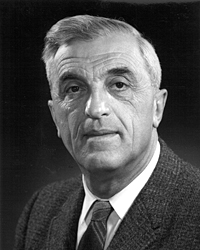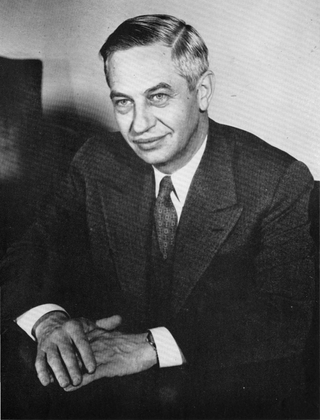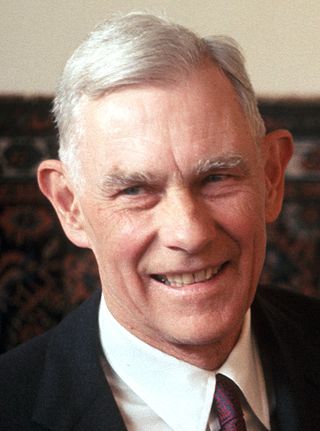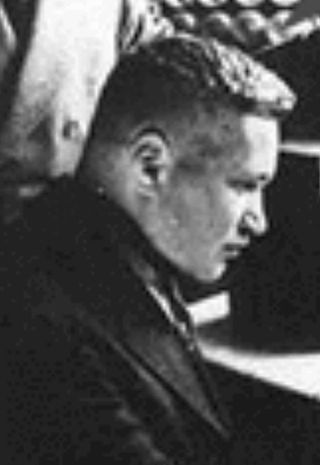
Felix Bloch was a Swiss-American physicist and Nobel physics laureate who worked mainly in the U.S. He and Edward Mills Purcell were awarded the 1952 Nobel Prize for Physics for "their development of new ways and methods for nuclear magnetic precision measurements." In 1954–1955, he served for one year as the first director-general of CERN. Felix Bloch made fundamental theoretical contributions to the understanding of ferromagnetism and electron behavior in crystal lattices. He is also considered one of the developers of nuclear magnetic resonance.

Niels Henrik David Bohr was a Danish physicist who made foundational contributions to understanding atomic structure and quantum theory, for which he received the Nobel Prize in Physics in 1922. Bohr was also a philosopher and a promoter of scientific research.

Hans Albrecht Bethe was a German-American theoretical physicist who made major contributions to nuclear physics, astrophysics, quantum electrodynamics, and solid-state physics, and who won the 1967 Nobel Prize in Physics for his work on the theory of stellar nucleosynthesis. For most of his career, Bethe was a professor at Cornell University.

Philip Warren Anderson was an American theoretical physicist and Nobel laureate. Anderson made contributions to the theories of localization, antiferromagnetism, symmetry breaking, and high-temperature superconductivity, and to the philosophy of science through his writings on emergent phenomena. Anderson is also responsible for naming the field of physics that is now known as condensed matter physics.

John Hasbrouck Van Vleck was an American physicist and mathematician. He was co-awarded the Nobel Prize in Physics in 1977, for his contributions to the understanding of the behavior of electronic magnetism in solids.

Val Logsdon Fitch was an American nuclear physicist who, with co-researcher James Cronin, was awarded the 1980 Nobel Prize in Physics for a 1964 experiment using the Alternating Gradient Synchrotron at Brookhaven National Laboratory that proved that certain subatomic reactions do not adhere to fundamental symmetry principles. Specifically, they proved, by examining the decay of K-mesons, that a reaction run in reverse does not retrace the path of the original reaction, which showed that the reactions of subatomic particles are not indifferent to time. Thus the phenomenon of CP violation was discovered. This demolished the faith that physicists had that natural laws were governed by symmetry.

William Alfred Fowler (August 9, 1911 – March 14, 1995) was an American nuclear physicist, later astrophysicist, who, with Subrahmanyan Chandrasekhar, was awarded the 1983 Nobel Prize in Physics. He is known for his theoretical and experimental research into nuclear reactions within stars and the energy elements produced in the process and was one of the authors of the influential B2FH paper.

Lee Alvin DuBridge was an American educator and physicist, best known as president of the California Institute of Technology from 1946–1969.

VictorFrederick "Viki" Weisskopf was an Austrian-born American theoretical physicist. He did postdoctoral work with Werner Heisenberg, Erwin Schrödinger, Wolfgang Pauli, and Niels Bohr. During World War II he was Deputy Division Leader of the Theoretical Division of the Manhattan Project at Los Alamos, and he later campaigned against the proliferation of nuclear weapons.

Maurice Goldhaber was an American physicist, who in 1957 established that neutrinos have negative helicity.

Sidney David Drell was an American theoretical physicist and arms control expert.

Edoardo Amaldi was an Italian physicist. He coined the term "neutrino" in conversations with Enrico Fermi distinguishing it from the heavier "neutron". He has been described as "one of the leading nuclear physicists of the twentieth century." He was involved in the anti-nuclear peace movement.

David Mathias Dennison was an American physicist who made contributions to quantum mechanics, spectroscopy, and the physics of molecular structure.

Lew Kowarski was a Russian-French physicist. He was a lesser-known but important contributor to nuclear science. He participated in the British Tube Alloys on early nuclear weapon research. After the war he worked at CERN.

Herbert Lawrence Anderson was an American nuclear physicist who was Professor of Physics at the University of Chicago.

Harold Melvin Agnew was an American physicist, best known for having flown as a scientific observer on the Hiroshima bombing mission and, later, as the third director of the Los Alamos National Laboratory.
Horace Richard Crane was an American physicist, the inventor of the Race Track Synchrotron, a recipient of President Ronald Reagan's National Medal of Science "for the first measurement of the magnetic moment and spin of free electrons and positrons". He was also noted for proving the existence of neutrinos. The National Academy of Sciences called Crane "an extraordinary physicist". The University of Michigan called him "one of the most distinguished experimental physicists of the 20th century". Crane was a chairman of the Department of Physics and a professor of physics at the University of Michigan, a member of the National Academy of Sciences.

Sam Aronson is an American physicist, formerly president of the American Physical Society in 2015 and also formerly the director of the Brookhaven National Laboratory from 2006 to 2012.
Ruth Speel Van de Water is an assistant physicist at the U.S. Department of Energy’s Brookhaven National Laboratory. She was also named a finalist in the postdoctoral category of the New York Academy of Sciences’ Blavatnik Awards for Young Scientists in 2011. Van de Water was one of six postdoctoral fellows and seven university faculty members chosen as finalists out of 150 applications for that year. Of those, four were chosen as winners.
Herbert Friedman was an American physicist and astronomer who did research in X-ray astronomy. During his career Friedman published hundreds of scientific papers. One such example is "Ultraviolet and X Rays from the Sun". Friedman worked at the Naval Research Laboratory (NRL) the entirety of his professional career, from 1940-1980. He was elected to the American Academy of Arts and Sciences and the United States National Academy of Sciences in 1960. He received the Eddington Medal of the Royal Astronomical Society in 1964. That same year, he was elected to the American Philosophical Society.

















